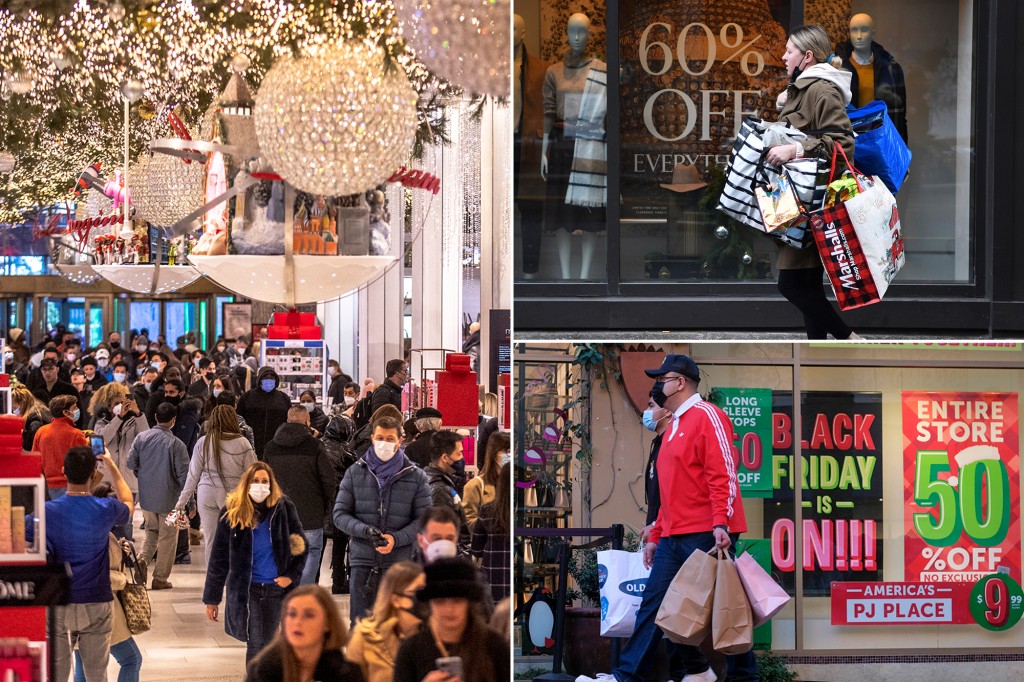Despite fewer juicy deals, Black Friday shoppers dutifully opened their wallets, and for the first time ever, online sales fell as crowds returned to stores.
Holiday-hungry consumers spent $8.9 billion online Friday, according to Adobe Analytics. That was a slight drop from $9 billion last year.
One reason for the dip: the online blitz started well before Thanksgiving Day. Adobe data shows consumers already spent more than $3 billion online on 19 separate days this season, compared with five last year, as stores rolled out discounts early – some as early as September.
There’s also been so much talk about shipping logjams and labor shortages — and so many emails advertising sales filling up inboxes — that many shoppers wanted to get a jumpstart on the gifting season.
“That really drove the early momentum,” said Vivek Pandya, Lead Analyst, Adobe Digital Insights, adding that the early returns for the season show solid momentum.
“It’s a retailer’s dream,” said Rob Garf, vice president and general manager of retail for Salesforce.com, which tracks shopping data. Stores hope each year that shoppers get started early in the season, he explained. That will help the stores avoid “discount chicken,” where they lower prices to draw shoppers away from competitors as the holiday season goes on.
On Thanksgiving Day alone, online shoppers spent $5.1 billion before the pumpkin pie was finished, according to Adobe. The figure matched last year’s turkey day tally, but was at the low end of Adobe’s $5.1 billion- $5.9 billion forecast.
Complete data for in-store sales results were not yet released, leaving open the question whether online sales topped the in-person kind again, after taking the No. 1 spot for the first time last year. Pandya, however, said there’s usually about $4 spent in store for each $1 spent online.

Through 3 p.m. Friday, retail sales surged 29.8 percent from last year’s COVID-pressured low, according to Mastercard SpendingPulse, which tracks both cash and credit payments. In-store sales leaped 43 percent from last year’s pandemic-suppressed state.
A good portion of the crowds rebounded as well.
Lines returned to metro area stores like Manhattan’s Best Buy and Macy’s flagship in Herald Square on Friday, with shoppers stating they felt good to be out again after staying home for too long.

Nearly 100,000 people headed to the Mall of America in Bloomington, Minnesota as of early Friday afternoon, more than double last year, but a bit shy of 2019’s numbers for the country’s largest mall, The Associated Press reported.
“We had a fantastic start,” said Mall of America senior vice president Jill Renslow.
But the pandemic likely permanently converted a good portion of the shop-til-you-drop crowd to their keyboards.
“The old-school ‘I need to wait and get in on Black Friday and line up’ is no longer,” said Angeli Gianchandani, a marketing professor at the University of New Haven. “That deal that you used to find on Black Friday that everybody would line up at the store and try and grab, that’s not happening.”

“Now it’s Black November,” she added. “There’s so many more alternatives now. It’s not a one-size-fits all.”
Kristin McGrath,a shopping expert at BlackFriday.com, agreed. “Black Friday is no longer constrained,” she said. “It defies the laws of physics and time and is a season.”
The average discount on Thanksgiving Day was 27 percent in the U.S., a decline of 7 percent from last year, according to Salesforce.com.
The value of orders placed on Thanksgiving Day jumped 11 percent, even though consumers actually bought fewer items, reflecting this year’s persistent inflation.

Among the most popular items: Nintendo’s Switch and other game consoles, the Apple iPhone 13 and the Oculus headset. “If you can get a PS 5 it’s like getting a gold coin,” said Dan Ives, a tech analyst with Wedbush. He said those items will be increasingly in short supply as the holidays continue.
“The supply chain issues have taken off about 20 percent of supply going into the holidays,” he said. However, as the clogged ports open up, that may provide a new surge of these popular products for last-minute shoppers.
Well-publicized logistics problem have already created some concerns about receiving online gifts on time. Many retail websites are sporting banners warning online shoppers to place their orders early, in order to receive them in time to tuck them under the Christmas tree. The US Postal Service said Dec. 15 is the last day for packages expected to arrive by Dec. 25.
